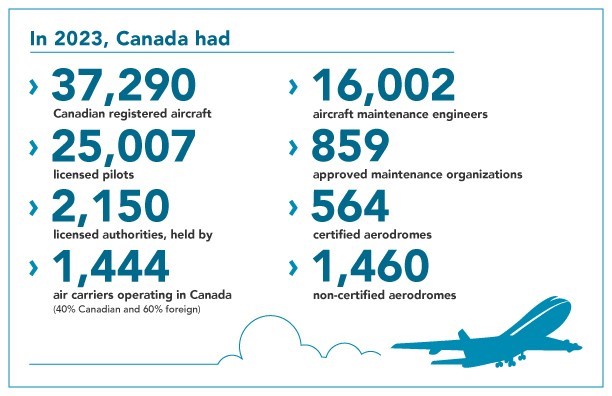Image description: Air Transportation Network
Key Traffic and Volume Statistics
The map of Canada shows the 26 airports of the NAS. Each airport, represented by a black plane in a white circle, is identified geographically to illustrate basic air infrastructure. Seven of these airports are located in the Atlantic Provinces, three in Québec, four in Ontario, six in the Prairie Provinces and three in British Columbia. Three other airports are found in the capital of each territory.
Canada’s air transportation system connects Canada to the world and moves passengers across the country, which spans 6 time zones and covers about 18 million square kilometres.
Canadian airspace is managed by NAV CANADA, a privately run, not-for-profit corporation that owns and operates Canada’s civil air navigation system. It operates air traffic control towers at 42 airports and flight service stations (facilities that provide information and services to pilots before, during, and after flights) at 55 airports.
The Canada Flight Supplement and Canada Water Aerodrome Supplement listed 2,012 certified and registered sites in 2022, and 12 other military landing sites. The sites fall into three categories:
- 343 water aerodromes for float and ski planes
- 427 heliports for helicopters, and
- 1,254 land aerodromes for fixed-wing aircraft
Description
In 2023, Canada had 37,290 Canadian registered aircraft, 25,007 licensed pilots, 2,150 licensed authorities held by 1,444 air carriers operating in Canada (40% Canadian and 60% foreign), 16,002 aircraft maintenance engineers, 859 approved maintenance organizations, 564 certified aerodromes and 1,460 non-certified aerodromes.
| Airline | Highlights |
|---|---|
|
Air Canada |
|
|
WestJet |
|
|
Porter Airlines |
|
|
Air Transat |
|
|
Sunwing Airlines |
|
